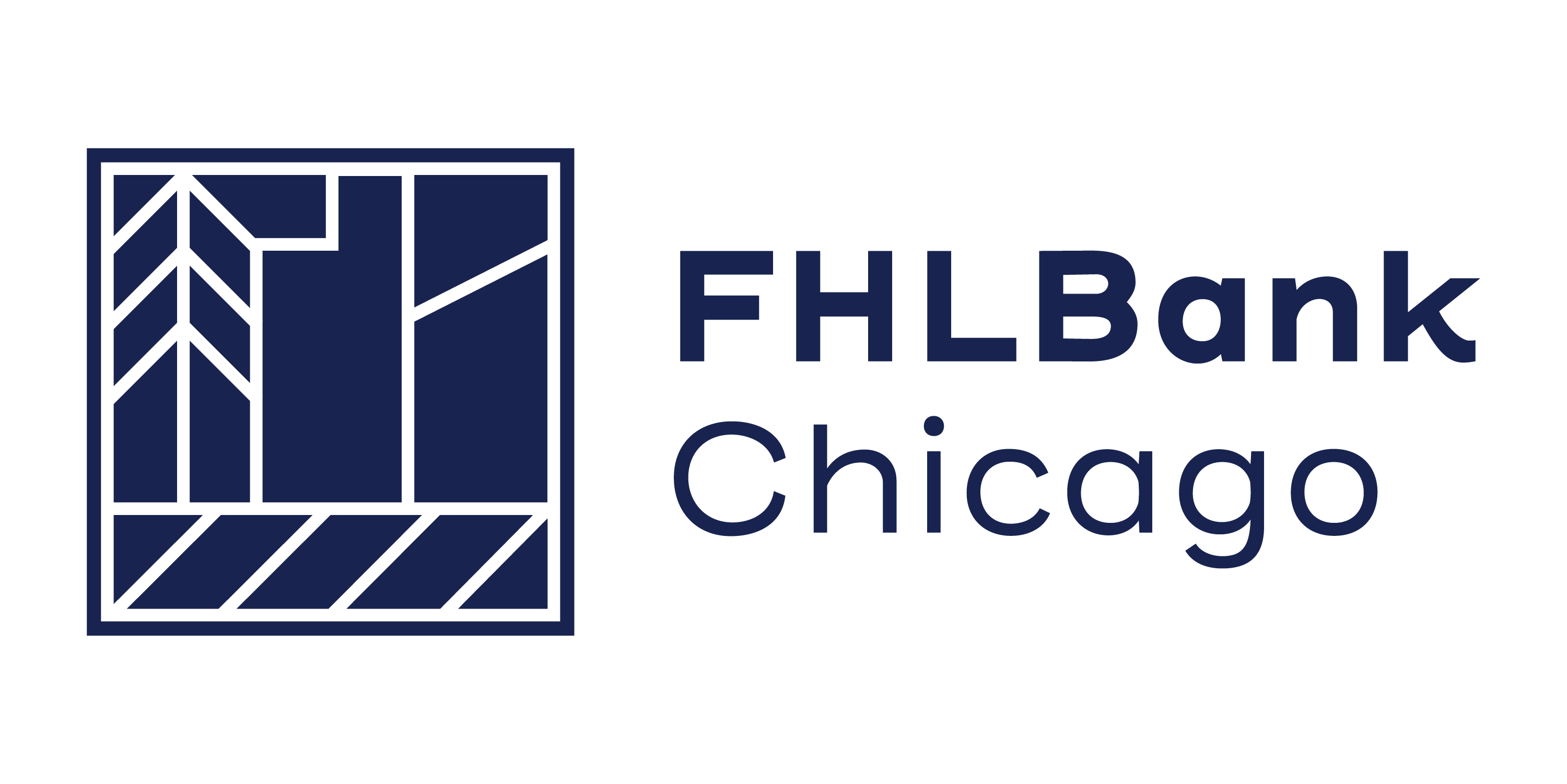Balance Sheet Leverage Strategies Using Agency MBS: Q3 2019
Overview
The current state of the global economy and investor sentiment has shifted yields down across many fixed-income markets. This has made finding attractive spreads more difficult for financial institutions. However, mortgage-backed securities funded with fixed rate advances from the Federal Home Loan Bank of Chicago (FHLBank Chicago) can still offer reasonable spreads, with little change to risk-based capital ratios. In this paper, we discuss purchasing a $25M portfolio of MBS funded with a ladder of FHLBank Chicago fixed rate advances.
MBS Investment Portfolio
The $25M MBS portfolio described in Table 1 is approximately 75% fixed rate MBS and 25% adjustable-rate mortgage (ARM) securities. The portfolio pricing is as of August 15, 2019.
Funding Strategy: Option 1
The advances suggested to fund this strategy include a ladder of fixed funding focused on the “belly” of the curve, with the largest allocation in maturity lengths between 3 and 5 years (see Table 2). Approximately 25% of the funding comes from deposits or short-term financing at an average rate of 1.16%. Advance and deposit data is as of August 15, 2019.
The income that a financial institution could make by following the strategy can be seen in the Table 3. The starting net interest margin (NIM) of the strategy is 1.04%, and has a 10-year average NIM range of 0.72% to 0.92% as you move from a -100-basis point interest rate shock scenario to a +100-basis point scenario.
Financial institutions could increase their return on average assets (ROAA) and return on average equity (ROAE) in the future accounting for the net interest earned on the strategy with rates unchanged from today. Table 4 shows the effect of this strategy on sample ratios created from the averages of Illinois and Wisconsin banks using call report data from Q2 2019.
The MBS portfolio has negative convexity because the underlying loans can be prepaid. “Negative convexity” is a term used to describe assets which lose value as rates fall because of prepayments. When rates fall, borrowers refinance their higher-rate mortgages, and investors receive principal back at par instead of a premium. However, the higher overall return of the MBS portfolio versus the borrowing costs could justify this risk. See Figure 2 for the estimated annualized portfolio return and funding costs projected 1 and 3 years out in different interest rate scenarios. The horizon charts in Figure 2 include interest and market value change. The returns only apply if you liquidate on the horizon date.
Funding the MBS Portfolio: Option 2
Institutions willing to take on more risk may want to consider adding putable advance funding to the mix. A putable advance gives the FHLBank Chicago the right to terminate after the lock out period. In return for selling this option, the member typically receives a considerably discounted rate. For example, a 10-year fixed rate advance costs 2.05% as of August 15, 2019. That same advance, with an option controlled by the FHLBank Chicago to terminate or “put” the advance every three months going forward, has a rate of 0.84%. See Table 5 for a ladder of funding that includes a putable advance.As shown in Figure 2, the advance balance covers most of the funding. Similarly to Option 1, deposits or other sources of funding are expected to fill in the gaps. Note that the longer putable advance is shown with a duration of 10 years in Figure 3, but could be put every three months thereafter.
The income a financial institution could make using Option 2 is illustrated in Table 6. The strategy has a NIM of 1.21% and a 10-year average NIM range of 0.76% to 0.82% as you move from a -100-basis-point shock scenario to a +100-basis-point scenario.
Financial institutions could increase their ROAA and ROAE in the future, accounting for the net interest earned on the strategy with rates unchanged from today. Table 7 shows the effect of this strategy on sample ratios based on the averages of Illinois and Wisconsin banks from call report data.
The funding strategy built with a ladder of mostly fixed advances and a single putable advance creates some extension risks. With the increased risk of higher costs in different interest rate scenarios, comes the benefit of a lower starting rate. The benefit is realized if interest rates have low volatility throughout the life of the portfolio. Rising rates will result in the advance getting put, eliminating the low-rate benefit. Falling rates extend the advance to its full duration, forcing the member to pay a relatively high rate for a longer period of time. The extension risk of the putable advance allows for a lower rate of 0.84% in comparison to the current 10-year fixed advance rate at 2.05%. See Figure 4 for the estimated annualized portfolio return and funding costs projected 1 and 3 years out in different interest rate scenarios. The horizon charts in Figure 4 include interest and market value change. These returns only apply if you liquidate on the horizon date.
Leverage’s Effect on Capital and Other Ratios
Leverage may change capital, asset, equity and other ratios, such as ROAE, return on assets ROAA, and return on risk-based capital. Illinois and Wisconsin banks that are FHLBank Chicago members have an average of $461M in total assets as of Q2 2019, excluding the top 5 largest banks. The $25M portfolio strategy proposed in this paper represents only 5% of those average assets. Yet, it can make an impact to the bottom line. Table 8 shows the effect of Option 1 on sample ratios created from the averages of Illinois and Wisconsin banks.After 1 year, this strategy would add an estimated 22 basis points to a member’s ROAE and 3 basis points to its ROAE assuming rates remain unchanged. Adding agency MBS to the portfolio will negatively impact the risk-based capital ratio by an estimated 15 basis points because of their 20% risk weighting. However, other assets (such as private mortgage loans with risk weightings of 100%) would impact this ratio more significantly. Earning an additional 32 basis points on risk-based capital could justify this reduction to the risk-based capital ratio, especially if the ratio meets regulatory standards. Members would see increases to net income, ROAA, and ROAE over the next 3 years, assuming interest rates move gradually between -100 and +100-basis points.
The second strategy’s effect on ratios is shown in Table 9. Option 2 involved the use of a putable advance, increasing estimated returns in comparison to Option 1.
Using a putable advance for 20% of the funding in this strategy would increase ROAA and ROAE in many of the estimated future value scenarios. Assuming interest rates remain unchanged, ROAA and ROAE would both be higher than in Option 1. Three years after executing this strategy, members could experience increases to ROAA and ROAE of 5 and 42 basis points, respectively. Option 2 comes with more risks in volatile interest rate scenarios. For example, if rates fell 100 basis points over the next 3 years, the estimated return on risk-based capital would to be lower than in Option 1.
Keep in mind that while MBS securities are used in this leverage strategy, a variety of other investments could be used, such as Commercial mortgage-backed securities (CMBS) bonds, municipal bonds, corporate bonds, etc. Members can also use many different advance structures, with or without embedded options, to meet their needs.
To Learn More
If your institution would like more specific information about part or all of this strategy, please feel free to reach out to the solutions team or your Sales Director.Contributors

Nick Simoncelli
Senior Analyst, Member Strategy and Solutions

Ashish Tripathy
Managing Director, Member Strategy and Solutions
Disclaimer
The data, scenarios and valuations provided to you in this paper are for information purposes only and are provided as an accommodation and without charge. The data, scenarios and valuations are estimates only and may not represent the actual or indicative terms at which new (or economically equivalent) transactions could be entered into or the actual or indicative terms at which existing (or economically equivalent) transactions could be prepaid, terminated, liquidated, assigned or unwound. The scenarios and valuations were derived using proprietary pricing models and estimates and assumptions about relevant future market conditions and other matters, all of which are subject to change without notice. The scenarios in this paper were prepared without any consideration of your institution’s balance sheet composition, hedging strategies, or financial assumptions and plans, any of which may affect the relevance of these scenarios to your own analysis. The Federal Home Loan Bank of Chicago makes no representations or warranties about the accuracy or suitability of any information in this paper. This paper is not intended to constitute legal, accounting, investment, or financial advice or the rendering of legal, accounting, consulting, or other professional services of any kind. You should consult with your accountants, counsel, financial representatives, consultants, and/or other advisors regarding the extent these scenarios may be useful to you and with respect to any legal, tax, business, and/or financial matters or questions.Federal Home Loan Bank of Chicago | Member owned. Member focused. | October 2019

